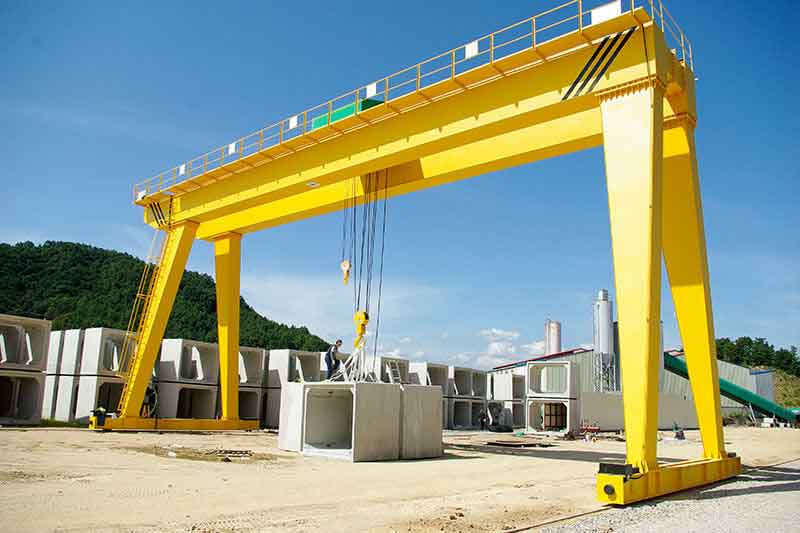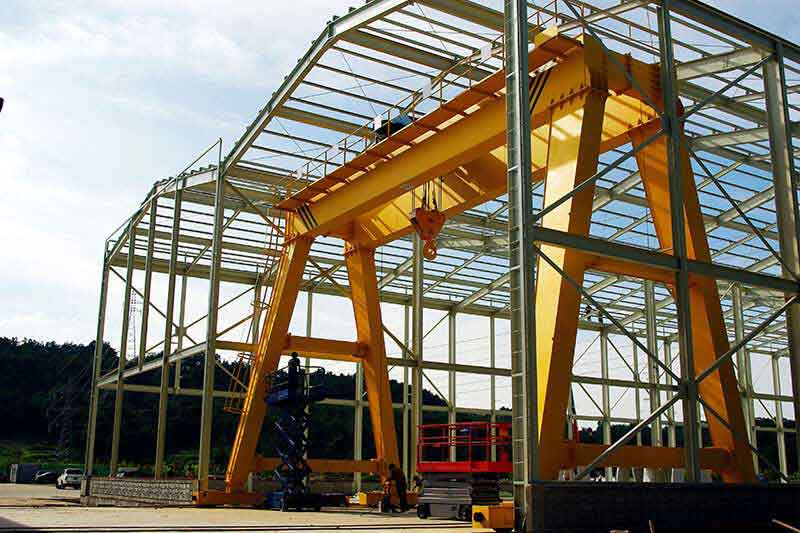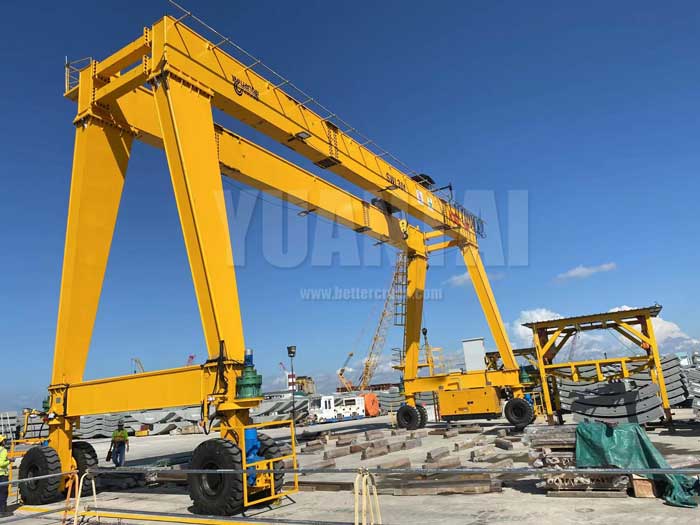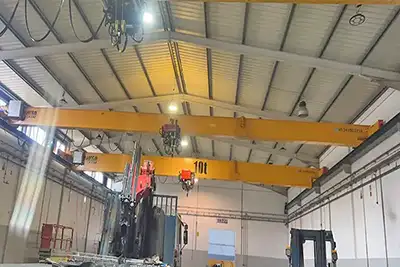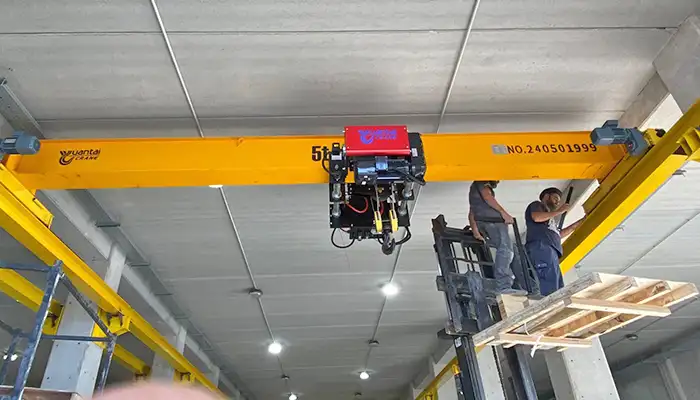Double Girder Gantry Cranes for Railroad Tie Mold Handling
Gantry cranes, with their towering structures and impressive lifting capabilities, play a pivotal role in various industrial applications. One specific area where their significance shines is in rail yard operations. These cranes are robust and versatile, making them ideal for handling heavy loads efficiently.
Rail yard operations involve the movement, storage, and assembly of materials critical to the functioning of rail infrastructure. Gantry cranes, owing to their strength and mobility, are indispensable in expediting these processes. Their ability to lift and transport heavy loads with precision ensures the seamless functioning of rail yards, contributing to overall operational
Within the realm of rail yard operations, a specific application stands out— the handling of railroad tie molds. These molds are crucial components in the production of durable concrete railroad ties, forming the backbone of rail infrastructure. Gantry cranes, tailored for this purpose, play a crucial role in maneuvering and positioning these molds, ensuring a streamlined and efficient production process.
Double Girder Gantry Cranes for Railroad Tie Mold HandlingGantry cranes, the unsung heroes of material handling, are characterized by their imposing overhead structure supported by vertical legs. The primary purpose of these cranes lies in their ability to lift, move, and position heavy loads with precision. Rail yards, with their diverse material handling needs, find gantry cranes indispensable for ensuring efficient operations.
Gantry cranes boast a distinctive set of features that contribute to their effectiveness. The horizontal bridge, or span, supported by vertical legs is a defining characteristic. Additionally, end trucks equipped with wheels facilitate smooth movement along tracks, while the hoist or trolley system handles the actual load.
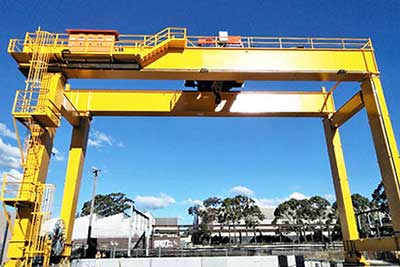 rail mounted double girder gantry crane , good price
rail mounted double girder gantry crane , good priceRTGs stand out as mobile powerhouses, mounted on rubber tires for increased flexibility. Their ability to navigate different terrains makes them a popular choice in rail yard operations. RTGs can swiftly move and position heavy loads, offering a dynamic solution to the ever-changing demands of rail yards.
In contrast, RMGs are fixed cranes that traverse along a set of rails. Stability is a key advantage, allowing them to handle high-capacity loads efficiently. RMGs are ideal for rail yards with dedicated tracks, providing a reliable and precise solution for material handling.
Smart Features of Intelligent Gantry Cranes
Unveiling the Intelligence: Exploring Key Features of Gantry Cranes
Electric wire rope hoists have undergone a transformative evolution, becoming pioneers of intelligent features that redefine material handling capabilities. Let's delve into the key intelligent features that set modern hoists apart, each designed to address specific challenges and elevate operational efficiency and safety.

Extended Speed Range:
Explanation of Variable Speed Control:
The Extended Speed Range feature empowers hoists to operate within a versatile speed spectrum. Variable speed control allows for precise adjustments in the speed of crane movements, catering to diverse operational requirements. This feature ensures maximum performance at all times, offering flexibility in adapting to varying load conditions and tasks.
Benefits for Different Operational Requirements:
Higher productivity with optimized speed adjustments.
Time savings through faster hoisting speed, particularly advantageous when lifting smaller loads.
Enhanced adaptability to dynamic work environments, making the hoist a versatile tool in various industrial settings.

Micro Speed:
Precision in Load Handling:
Micro Speed is a testament to the hoist's ability to move at extremely slow and controlled speeds. This feature ensures precision in load handling, crucial for tasks that demand meticulous positioning. The hoist's capability to operate at micro speeds facilitates delicate handling of sensitive loads with unparalleled accuracy.
Applications for Delicate or Sensitive Loads:
Ideal for handling fragile or sensitive materials requiring careful positioning.
Ensures gentle and controlled movements, preventing any unintended impact on delicate loads.
Precision becomes paramount in applications such as precision manufacturing or laboratory environments.

Slack Rope Prevention:
Importance in Safety:
Slack Rope Prevention is a safety feature that eliminates the presence of slack or loose rope during hoist operations. This feature is instrumental in preventing accidents and load instability caused by slack in the lifting mechanism. It ensures that the rope remains taut, contributing to a safer working environment.
Constant Tension Monitoring and Emergency Stop Functionality:
Continuous monitoring of rope tension to prevent slack.
Immediate activation of emergency stop functionality when slack is detected.
Safeguards against potential hazards, protecting both equipment and personnel.

Inching:
Control Mechanism for Small Movements:
Inching is a control mechanism that empowers crane operators to make minute, incremental movements. This feature is particularly beneficial for fine tuning the crane's position with utmost precision. It allows operators to navigate tight spaces or align loads with unparalleled accuracy.
Benefits in Fine Tuning Crane Position:
Facilitates meticulous positioning of the crane.
Enables operators to navigate through intricate spaces with ease.
Ideal for applications requiring precision in load placement, ensuring optimal alignment.

Restricted Load:
Protection Against Overloading:
The Restricted Load feature imposes limitations on the maximum load capacity the crane can handle. This preventative measure protects against overloading, ensuring that the crane operates within its specified limits. It contributes to safety and enhances the longevity of equipment components.
Contribution to Safety and Equipment Longevity:
Prevents overloading, reducing the risk of equipment strain or failure.
Ensures safe operations by adhering to specified load capacity limits.
Extends the service life of the crane and its components.

Sway Control:
Technology for Load Stability:
Sway Control is a technological advancement designed to minimize the swinging or swaying of the load during lifting or movement. This feature enhances safety and precision, especially when dealing with heavy or sensitive loads that are susceptible to unintended movements.
Applications in Heavy Load Handling:
Enhances stability during lifting and movement of heavy loads.
Minimizes the risk of load sway, ensuring controlled and secure operations.
Critical for applications where load stability is paramount, such as construction or heavy manufacturing.
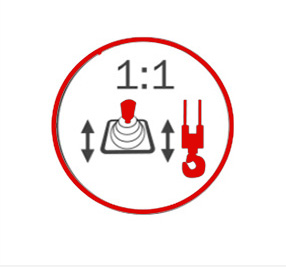
Load Floating:
Maintenance of Consistent Load Height:
Load Floating allows the crane to maintain a consistent load height regardless of variations in load weight. This feature is particularly useful in applications where maintaining a constant height is critical for the success of the operation.
Applications in Critical Load Operations:
Ensures a consistent load height, critical for precision applications.
Particularly useful when handling loads with varying weights consecutively.
Enhances overall operational efficiency and load stability.

Shock Load Prevention:
Safety Feature Against Sudden Impacts:
Shock Load Prevention is a safety feature that protects the crane and the load from sudden jolts or impacts during lifting or movement. This feature absorbs and mitigates shocks, reducing the risk of equipment damage, structural strain, or load instability.
Measures for Equipment and Load Protection:
Real time monitoring detects sudden changes in load conditions.
Automatic adjustments to the lifting mechanism to absorb and reduce impact forces.
Protects against structural damage and ensures stable load handling.
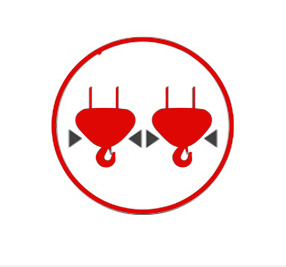
Tandem Synchronization:
Coordinated Operation of Multiple Cranes:
Tandem Synchronization facilitates the coordinated operation of multiple cranes working together. This technology ensures that two or more cranes move in sync, allowing for the lifting and movement of larger and more complex loads that may exceed the capacity of a single crane.
Lift Capacity Optimization and Efficiency:
Coordinated movement for stability and balance when lifting oversized loads.
Centralized control system for simultaneous operation of multiple synchronized cranes.
Load sharing mechanisms for even distribution of weight among synchronized cranes.
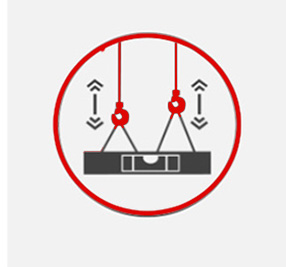
Cranes in Tandem:
Simultaneous Operation for Heavy Loads:
Cranes in Tandem specifically address the simultaneous operation of multiple cranes to lift and transport heavy or oversized loads. This feature allows multiple cranes to work together, often synchronized, to achieve a common lifting goal.
Enhanced Safety and Load Handling:
Simultaneous long travel and hoisting movements for heavy loads.
Synchronized lifting and lowering for optimal load control.
Improved safety through coordinated operations, reducing the risk of accidents.

Synchronization:
Continuous Monitoring for Asymmetrical Loads:
Synchronization involves the continuous monitoring of crane movements, even with asymmetrical loads. This feature reduces the risk of accidents and enhances operational benefits by ensuring that the cranes operate in harmony, responding to load conditions in real time.
Accidents Reduction and Operational Benefits:
Real time adjustments to crane movements for load balance.
Reduction in the risk of accidents caused by asymmetrical loading.
Enhanced efficiency and safety through synchronized crane operations.
Suitability for Different Loads
Gantry cranes are not one-size-fits-all; their suitability for handling different loads depends on various factors.
- Factors Influencing Crane Selection -Selecting the right gantry crane involves careful consideration of factors such as load capacity, span, and height. Understanding the specific requirements of rail yard operations ensures optimal crane performance.
- Importance of Crane Type Matching Load Requirements -Different gantry crane types are tailored for specific loads and applications. Matching the crane type to the load is critical for achieving efficiency, safety, and longevity in material handling operations.
- Customization for Railroad Tie Mold Handling -Railroad tie molds, being unique in their construction and weight, often necessitate customization. Gantry cranes can be adapted and fine-tuned to handle these molds with precision, ensuring a seamless and efficient production process for concrete railroad ties.
As we delve deeper into the world of gantry cranes, the next part of this blog will focus on the typical loads handled by these industrial giants, with a specific spotlight on molds used in the production of concrete railroad ties. Join us on this journey through the intricacies of rail yard material handling.
Typical Loads Handled
Railroad tie molds , integral to the rail infrastructure, serve as the foundational components for durable concrete railroad ties. These molds play a pivotal role in shaping the ties that support the tracks, ensuring the stability and longevity of the rail network. The precision and quality of these molds directly impact the reliability of the entire rail system.
The construction of railroad tie molds involves the use of robust materials to withstand the demanding conditions of concrete casting. Typically, these molds are crafted from durable materials such as steel or reinforced plastic, ensuring longevity and resilience in the face of continuous use.
Molds for Casting Concrete Railroad Ties
- Construction and Design -The construction of molds for casting concrete railroad ties is a meticulous process. The molds must be designed to withstand the pressure and forces exerted during the concrete casting process. Reinforcements, intricate designs, and precision engineering are key elements in crafting molds that consistently produce high-quality railroad ties.
- Dimensions and Weight Considerations -Railroad tie molds come in various dimensions, depending on the specifications of the railroad ties they are intended to produce. The weight of these molds is a critical factor, as it influences the choice of gantry crane and the precision required in handling and positioning the molds. Gantry cranes, with their adaptability, are well-suited for managing the varying dimensions and weights of these molds.
Challenges in Handling Railroad Tie Molds
- Precision and Care Requirements -Handling railroad tie molds demands a high level of precision and care. The intricate design and construction of the molds require gantry cranes to maneuver with accuracy, ensuring that the molds are not damaged during the lifting, transporting, and positioning processes. Precision is not just a requirement; it's a critical factor in maintaining the integrity of the molds and the quality of the railroad ties produced.
- Safety Considerations -Safety is paramount in any industrial operation, and handling heavy molds for railroad ties is no exception. Gantry cranes equipped with advanced safety features play a crucial role in minimizing risks during material handling. Strict adherence to safety protocols and continuous monitoring further enhance the overall safety of the operation.
As we explore the challenges and intricacies of handling railroad tie molds, the next part of our blog will shed light on the typical crane applications in this specialized context. Stay with us as we unravel the role of gantry cranes in the production of durable railroad ties, ensuring the reliability and longevity of rail infrastructure.
Typical Crane Applications in Railroad Tie Mold Handling
Overview of Crane Applications
- General Material Handling -While gantry cranes are versatile tools for general material handling, their adaptability is particularly crucial in the dynamic environment of rail yards. These cranes excel in lifting, moving, and positioning various loads, contributing to the overall efficiency of rail yard operations.
- Specialized Applications for Mold Handling -The true prowess of gantry cranes emerges in their specialized applications, specifically in the realm of railroad tie mold handling. Gantry cranes are uniquely equipped to handle the intricate and weighty molds used in the production of concrete railroad ties. This specialization ensures that the critical components of rail infrastructure meet the highest standards of quality.
Handling and Positioning of Molds
- Loading and Unloading Processes -The loading and unloading of railroad tie molds require a delicate balance between power and precision. Gantry cranes, with their customizable features, provide the necessary strength to lift molds of varying weights. The ability to carefully load and unload molds is vital in preserving their integrity and ensuring the efficiency of the overall production process.
- Precision Placement for Production Efficiency -Gantry cranes shine in their capacity for precision placement. The molds used in casting concrete railroad ties must be positioned with accuracy to guarantee the quality and durability of the final product. The advanced control systems of gantry cranes enable operators to execute precise movements, contributing to the efficiency of the production line.
Role in Railroad Tie Production
- Contribution to Overall Rail Infrastructure -The role of gantry cranes in railroad tie mold handling extends beyond the immediate task at hand. By efficiently handling molds, these cranes contribute to the production of high-quality railroad ties. The reliability of these ties, in turn, contributes to the overall robustness and longevity of rail infrastructure.
- Ensuring Quality and Safety Standards -Gantry cranes play a pivotal role in upholding quality and safety standards in railroad tie production. The controlled movements and lifting capabilities of these cranes, combined with adherence to strict safety protocols, contribute to the prevention of damage to molds and the production of consistent, reliable railroad ties.
As we conclude our exploration of gantry cranes in the context of railroad tie mold handling, it is evident that these industrial giants are not merely machines but integral components in ensuring the strength and durability of rail infrastructure. In the final part of this series, we will touch upon the continuous improvements and technological advancements in gantry crane systems, shaping the future of rail yard operations. Join us in our journey through the evolution of these engineering marvels.
In our exploration of gantry cranes in the specialized domain of railroad tie mold handling, we've uncovered a world where precision meets power. Gantry cranes, with their towering structures and versatile configurations, play a pivotal role in the efficient movement, positioning, and care of molds crucial to the production of concrete railroad ties. The intricate dance between the cranes and these molds ensures the reliability and longevity of the very foundation of rail infrastructure.
The significance of gantry cranes in rail yard operations cannot be overstated. Rail yards, bustling hubs of activity, rely on the strength and adaptability of these cranes to handle a diverse range of materials. Whether in the general realm of material handling or the specialized task of maneuvering railroad tie molds, gantry cranes are the backbone of efficiency, contributing to the seamless functioning of rail yard operations.
Gantry cranes, with their towering presence and intricate capabilities, stand as a testament to the marriage of engineering prowess and operational efficiency. As technology continues to propel us forward, one can only anticipate the further refinement and innovation that will mark the next chapter in the story of gantry cranes and their indispensable role in rail yard operations.


